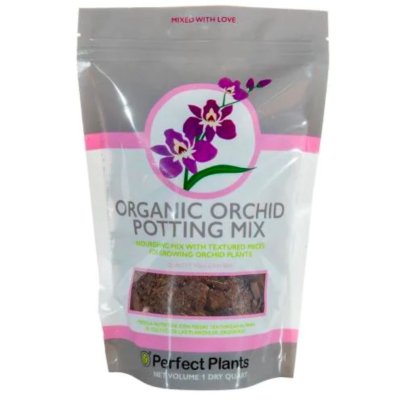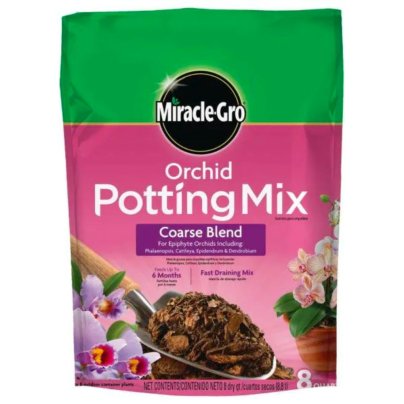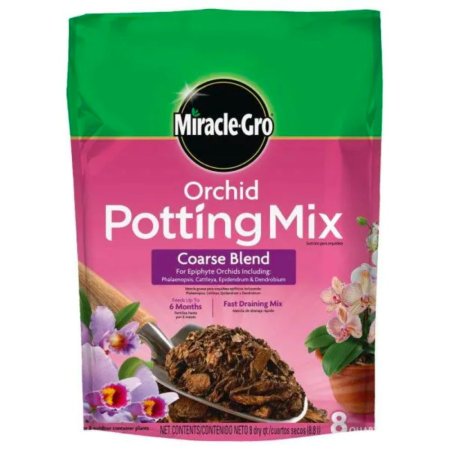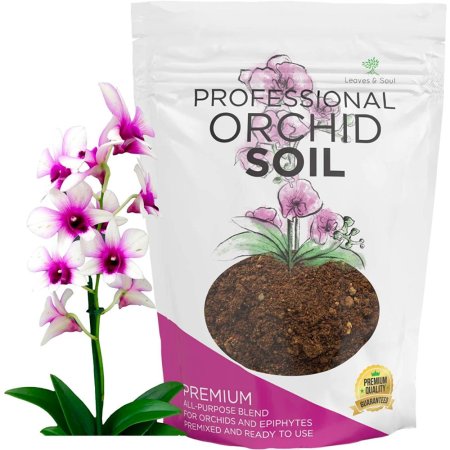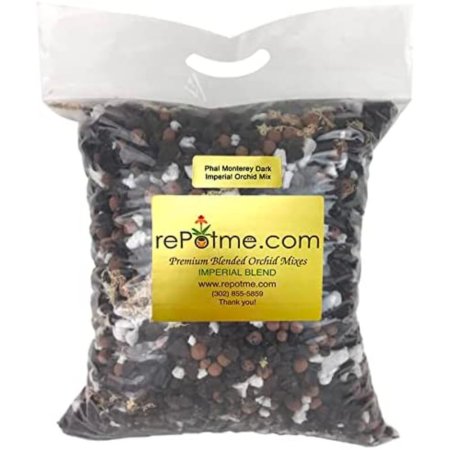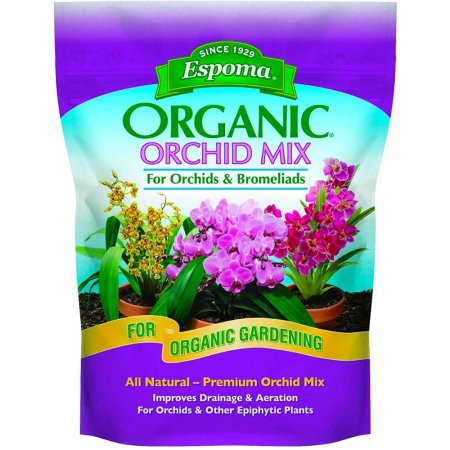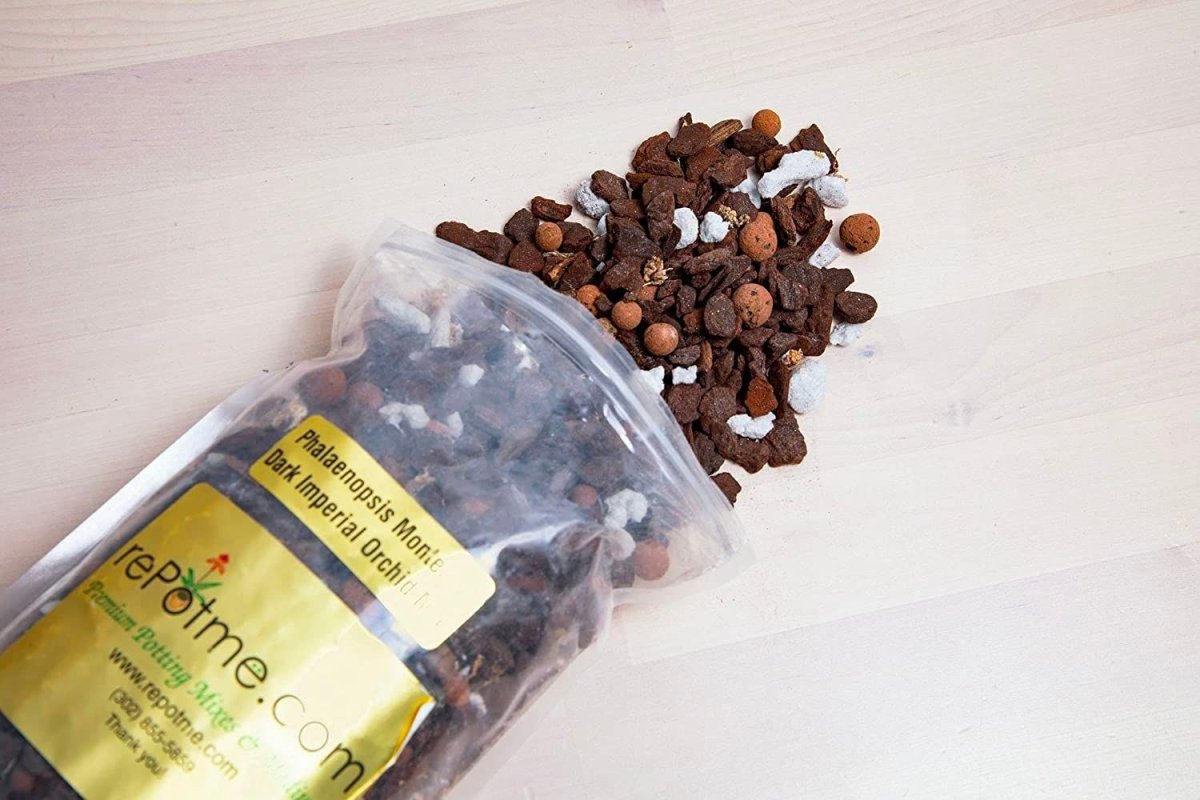
We may earn revenue from the products available on this page and participate in affiliate programs. Learn More ›
They start appearing in stores before the winter holidays and stick around through Valentine’s Day: beautiful orchids with delicate blossoms in a variety of bright colors. A single orchid plant can create a stunning focal point in a room, adding an elegant, exotic touch, but in the wrong type of soil, these tropical plants may languish and die. Regular potting soil, even if designed for indoor houseplants, is too dense and compact for orchids to grow well.
The best soil for orchids not only drains rapidly but also offers some support for the plant’s developing roots. Ahead, learn what to look for when selecting a soil mix for growing orchids and find out why the following soil blends can help boost healthy orchid growth.
- BEST OVERALL: Perfect Plants 1 Qt. Organic Orchid Potting Mix
- BEST BANG FOR THE BUCK: Miracle-Gro 8 Qt. Orchid Coarse Mix
- BEST FOR DRAINAGE: Leaves and Soul Orchid Soil Premium All Purpose Blend
- BEST FOR PHALAENOPSIS: rePotme Phalaenopsis Monterey Dark Imperial Orchid
- BEST ORGANIC: Espoma Organic Orchid Mix Potting Soil
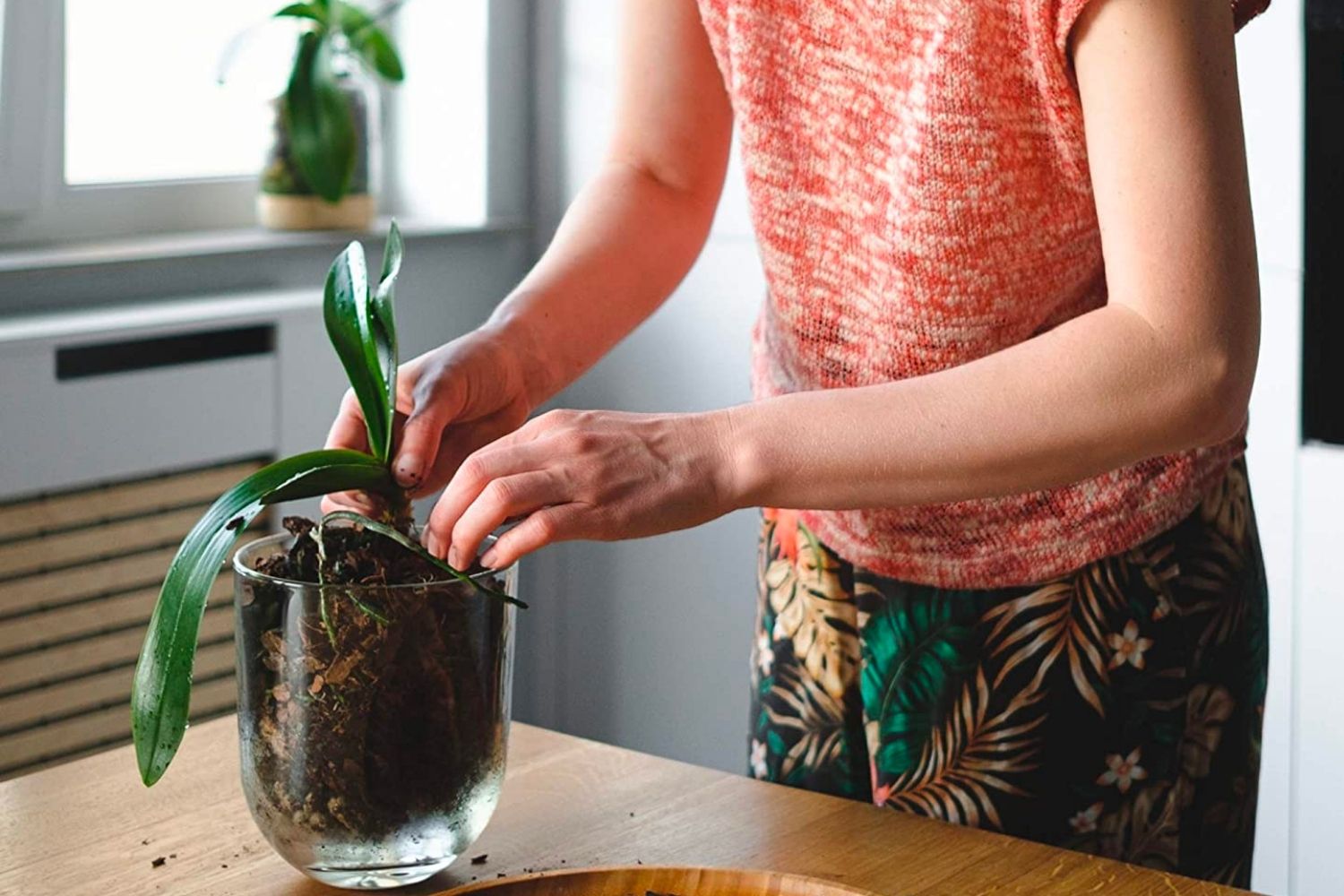
What to Consider When Buying the Best Soil for Orchids
Because orchids don’t like “wet feet,” the best orchid potting soil contains somewhat chunky ingredients so that water can drain rapidly. Prior to choosing the right soil, however, learn about orchid plants and their care. Today’s hybrids, though better suited as indoor houseplants than their finicky predecessors, thrive in a growing environment close to their natural habitat.
Most of the orchids in garden centers today are epiphytes, which means that in nature, they grow on other objects, such as tree trunks and rocky cliffs, where their roots can get a foothold. These kinds of orchids do poorly in boggy soil because their roots require access to air.
Orchid Types
Orchids available today fall into one of two classes: phalaenopsis or dendrobium. Both types have been hybridized to produce large, glorious blooms that can last for weeks with the right orchid care, but they differ in a few ways.
- Phalaenopsis: The most common type of hybridized orchid, phalaenopsis, also called the “moth orchid,” is monopodial, which means that all its foliage and blossoms grow on a single stem and have just one root system. Phalaenopsis orchid stems can grow quite tall and require stabilization (explained below).
- Dendrobium: Orchids of the dendrobium type have multiple root systems, classified as sympodial, and they can produce numerous blossom-bearing spikes. These orchids maintain a lush base of foliage at the soil level.
Organic Orchid Potting Mix Ingredients
Organic orchid mix, which is free from chemicals, often is a favorite of eco-conscious consumers.Orchid potting mixes labeled “organic” contain only natural products that have not been treated or exposed to chemical or synthetic substances.
For a potting mix to qualify as organic, all of its ingredients—not just a few—must be organic, and the product should be certified by the Organic Materials Review Institute (OMRI), a branch of the United States Department of Agriculture (USDA). The most common organic ingredients include:
- Bark: Includes fir bark, cedar bark, or pine bark chips, which are lightweight and chunky to encourage drainage.
- Sphagnum peat moss: Most potted orchids are planted in peat moss, which allows them to drain but retain some moisture. After blooming, the plant should be repotted in an orchid-growing mix.
- Coconut coir: This is a natural, fibrous husk between the coconut’s hard outer shell and the fruit inside. It’s an optimal ingredient in soil for orchids because it allows water to drain but retains moisture on its surface.
- Charcoal: With the ability to absorb salts and bacteria, charcoal is a frequent addition to orchid soil mixes. It reduces the risk of the plant roots absorbing harmful ingredients that may be present in tap water. Charcoal is considered organic only if it comes from burnt organic materials, such as untreated wood or peat.
- Perlite: A byproduct of volcanic glass, perlite may be an organic ingredient if it has not come into contact with chemicals during processing.
Inorganic Orchid Potting Mix Ingredients
Some inorganic orchid mixes contain mostly natural ingredients, such as bark or coconut coir, but they also include other ingredients that prevent their being certified as organic. Inorganic mixes also may contain beneficial synthetic fertilizers that can help boost plant growth. Even if a soil is completely natural and free from chemicals, if it hasn’t been certified as organic by the OMRI, it cannot bear an organic label.
Commonly found inorganic ingredients (that may or may not be natural) include:
- Leca: Short for “lightweight, expanded clay aggregate,” leca features clay bits that absorb water and release it slowly. Leca may be included in orchid soil mixes, but too high a percentage of the clay bits can cause the soil to retain too much water. Use leca sparingly.
- Seramis: This is another clay product that absorbs water and releases it slowly. Like leca, a little goes a long way.
- Charcoal: When charcoal is obtained from burnt inorganic materials, such as chemically treated wood, the resulting charcoal is considered inorganic. Both types of charcoal can be beneficial in orchid soil mixes.
- Lava rock: This porous rock may be in an orchid soil mix to keep the soil from compacting and to absorb excess water. It’s also a beneficial addition to soil used to grow moth orchids, as it offers a structural base that helps secure the roots in place.
- Fertilizer: Orchid mixes, such as those manufactured by garden-product kingpin Miracle-Gro, may contain synthetic or chemical fertilizers, which are designed to boost the plant’s health.
Stabilization
Low-growing (dendrobium) orchids don’t require support, but the popular phalaenopsis cannot stand upright without something to stabilize its long, lanky stem. Moth orchids are sold with one or two supports—narrow bamboo straws, wood dowels, or even plastic spikes—already in place.
When repotting a moth orchid, insert supports in the new soil to stabilize the stem. If desired, opt for a more artistic look, such as using natural branches to enhance the appeal. Gently tie the orchid stem to the support or attach it via gardening clips.
Aeration
While orchid roots need water, they grow best when allowed to dry out slightly between waterings. In their natural habitat, orchids often grow on tree trunks in tropical forests with their roots partially exposed. Plant them in soil that closely mimics the damp/dry cycle they prefer.
To promote adequate aeration, orchid soil mixes typically contain perlite, vermiculite, lava rocks, and other chunky items. The best potting soil for orchidcultivation should remain light and loose even after years of watering to give the plant’s roots an airy spot to grow.
Drainage
In addition to a soil mix that drains well, plant orchids in a suitable pot that encourages drainage. Orchid pots have holes not only on the bottom but also along the sides to let water drain out quickly.
All too often, commercial orchids are not planted in either the right pots or the best soil. As soon as a new orchid has finished blooming, repot it in an appropriate container with one of the orchid soils in this lineup to ensure the plant lives a long, healthy life.
Moisture
The biggest mistake newbie orchid growers make is giving their plants too much water. Optimally, water an orchid once per week during its slow-growth season, fall and winter, and then twice a week starting in early spring and continuing through summer.
When an orchid is in a suitable pot and soil, the amount of water it receives per watering doesn’t matter much because it will quickly drain out. When overwatering becomes a problem, it’s usually when the orchid is still in sphagnum peat moss in its original pot, which may not have drainage holes.
When an orchid is in its original pot without drainage holes, err on the side of caution and give it only a little bit of water during regular waterings. Some commercial growers recommend using one ice cube per every 2 inches of pot diameter to prevent overwatering. For example, three ice cubes placed on the soil in a 6-inch pot provides enough water. Place the ice cubes at the edge of the pot, not in contact with the orchid’s stem.
Our Top Picks
To earn a place in this lineup, soil mixes must be designed specifically to grow orchids. They all drain well, contain quality ingredients, and won’t pack down over time. After we carefully researched dozens of options for the best orchid soil, only a few made it to the top. Any one of these helps contribute to growing healthy, beautiful orchids.
Best Overall
Perfect Plants 1 Qt. Organic Orchid Potting Mix
Pros
- Organic ingredients
- Ready to use
- Maximum drainage and aeration
Cons
- A bit pricey
Product Specs
- Organic: Yes
- Designed specifically for orchids? Yes
- Extra nutrients: No added nutrients
This high-quality orchid potting mix features a blend of bark, coconut coir, perlite, and charcoal. Perfect Plants’ organic mix contains no synthetic ingredients or ingredients that may have come into contact with chemicals during processing.
The mix is premoistened, so it’s ready to use right out of the package and requires no mixing. It comes in a resealable bag to keep it from drying out. This potting mix will not compact over time, so orchids look as good years from now as they do the day they’re repotted.
Best Bang for the Buck
Miracle-Gro 8 Qt. Orchid Coarse Mix
Pros
- Large-size bark chips
- Drains rapidly
- Mimics orchids’ natural habitat
Cons
- Not organic
Product Specs
- Organic: No
- Designed specifically for orchids? Yes
- Nutrients: Added fertilizer
The primary ingredient in this budget-friendly potting soil comes from natural forest products, including large wood chips that allow water to drain quickly from the mix. The special mixture helps keep orchid roots healthy without becoming soggy.
This Miracle-Gro potting mix also contains a small amount of fertilizer designed to help orchids receive nutrients to produce large, beautiful blooms. While the bulk of the growing mix is natural, it doesn’t qualify as organic because of the addition of the fertilizer.
Best for Drainage
Leaves and Soul Orchid Soil Premium All Purpose Blend
Pros
- Lava rocks offer root support
- Drains rapidly
- Clay pellets retain moisture and release it slowly
Cons
- Not organic
Product Specs
- Organic: No
- Designed specifically for orchids? Yes
- Nutrients: No added nutrients
This orchid soil blend is designed specifically to drain rapidly while enhancing fertilizer absorption. Made by Leaves and Soul, the mix contains pine bark, ¼-inch lava rock, and clay pellets. The mix won’t compact over time, and it provides tiny pockets of air that orchid roots seek.
The clay pellets readily absorb water and fertilizer and release them gradually, so the orchid’s roots can access moisture and nutrients while enjoying adequate aeration. The lava rocks also help provide a stabilizing base for orchid roots to grow around, making this mix suitable for moth orchids.
Best for Phalaenopsis
rePotme Phalaenopsis Monterey Dark Imperial Orchid
Pros
- Drains well
- Offers root support
- Hand mixed for quality control
Cons
- Slightly pricey
Product Specs
- Organic: Contains natural ingredients but is not certified as organic
- Designed specifically for orchids? Yes
- Nutrients: No added nutrients
The delicate stems of phalaenopsis (moth orchid) require a supportive soil that drains well and offers ample air pockets, yet retains some moisture for a slightly damp feel. This rePotme orchid mix offers just that with its blend of white sponge rock (perlite), sphagnum moss, wood bark, and small clay pebbles. These ingredients work together to mimic the natural orchid habitat and give phalaenopsis orchids an optimal growing medium. Unlike many commercial grow mixes, the rePotme orchid mix is hand mixed in small batches.
Best Organic
Espoma OR4 Organic Orchid Mix Potting Soil, 4-Quart
Pros
- Certified organic
- Enhanced with mycorrhizae
- Optimal blend for orchids
Cons
- On the pricey side
Product Specs
- Organic: Yes
- Designed specifically for orchids? Yes
- Nutrients: Myco-tone, a proprietary blend of natural fungi nutrients
Espoma’s OR4 Organic Orchid Mix contains Western bark chips, perlite, and horticultural charcoal. The mix drains rapidly, the perlite defers compacting, and the charcoal absorbs water and removes salts and bacteria from the soil.
The Espoma blend also features Myco-tone, a proprietary blend of natural fungi known as mycorrhizae, which provides the nutrients orchids need, so no other fertilizer is necessary. Myco-tone helps the orchid’s roots absorb nutrients for healthier plants and brighter, more colorful blooms.
Our Verdict
While every orchid-growing mix in our lineup is well suited to cultivating healthy orchids, our best overall pick, Perfect Plants’ Organic Orchid Potting Mix, tops the list for growing tropical orchids. Budget-minded folks who need potting soil for orchids with added nutrients may prefer Miracle-Gro Orchid Coarse Mix, a light, aerated blend with a touch of fertilizer at an affordable price.
How We Chose the Best Soil for Orchids
In putting this guide together, we extensively researched dozens of orchid-specific growing mixes—from both well-known garden-product companies and smaller operations—to determine which products were best suited for these tropical plants. The most critical factor in orchid mixes is the ability to drain rapidly, since slow-draining and compacting soil is a death knell for orchids. So, while we also evaluated all-purpose indoor mixes, they didn’t make our final cut because of their tendency to retain too much moisture.
To determine the best potting mix for phalaenopsis orchids, we looked for soil that offered some structural stability, such as the inclusion of lava rocks. This helps to provide a firm foundation and keep a lanky stem from dislodging the roots from the soil.
We gave special attention to certified organic mixes, but we didn’t exclude quality soils that were not 100 percent organic if they were made from natural ingredients.
FAQs
Orchids have a reputation for being challenging to grow as a houseplant, but today’s new hybrids can withstand most indoor conditions as long as their soil drains well. Those wondering about what soil to use for orchids may still have a few questions, so keep reading for answers to some of the most common.
Q. Can you use all-purpose soil for orchids?
No. All-purpose potting soil (or garden soil) is too dense and retains water, making it an unsuitable growing medium for orchids.
Q. Can you use any bark for orchids?
Any type of commercial bark is probably acceptable as long as it’s sterilized. Avoid harvesting bark from trees, as it might contain bacteria, disease, or insects that could kill the orchid.
Q. Can you plant an orchid in dirt?
No. Regular dirt from a yard or garden is too dense for orchids to drain sufficiently, and it likely contains traces of bacteria or insects.
Q. Are used coffee grounds good for orchids?
Skip the coffee grounds. They’re too acidic for orchids, and they can add to the density of the soil mix and reduce drainage.
Q. Is bark or moss better for orchids?
Bark is the more important of the two ingredients. Sphagnum peat moss is used to pot orchids just before they go to market, but by itself, it retains too much moisture. After an orchid has finished blooming, repot it in a soil mix with a higher bark-to-moss ratio.
Q. How do you repot an orchid?
Wait until it has finished blooming, and then repot the plant in an orchid pot: a container with holes or slits on the sides to encourage drainage. Use a soil mix created specifically for growing orchids.
Q. How often should you water an orchid in bark?
Water once a week during the slow season (fall and winter) and twice per week in spring and summer.
